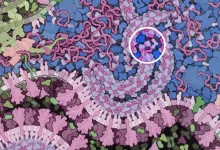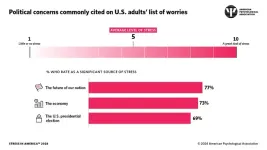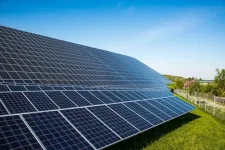(Press-News.org) The novel coronavirus SARS-CoV-2 has an enzyme that can counteract a cell’s innate defense mechanism against viruses, explaining why it is more infectious than the previous SARS and MERS-causing viruses. The Kobe University discovery may point the way to the development of more effective drugs against this and possibly similar, future diseases.
When a virus attacks, the body’s immune response has two basic layers of defense: the innate and the adaptive immune systems. While the adaptive immune system grows stronger against a specific pathogen as the body is exposed to it multiple times and which forms the basis of vaccinations, the innate immune system is an assortment of molecular mechanisms that work against a broad range of pathogens at a basic level. The Kobe University virologist SHOJI Ikuo says, “The new coronavirus, however, is so infectious that we wondered what clever mechanisms the virus employs to evade the innate immune system so effectively.”
Shoji’s team previously worked on the immune response to hepatitis viruses and investigated the role of a molecular tag called “ISG15” the innate immune system attaches to the virus’s building blocks. Having learned that the novel coronavirus has an enzyme that is especially effective in removing this tag, he decided to use his team’s expertise to elucidate the effect of the ISG15 tag on the coronavirus and the mechanism of the virus’s countermeasures.
In a paper in the Journal of Virology, the Kobe University-led team is now the first to report that the ISG15 tag gets attached to a specific location on the virus’s nucleocapsid protein, the scaffold that packages the pathogen’s genetic material. For the virus to assemble, many copies of the nucleocapsid protein need to attach to each other, but the ISG15 tag prevents this, which is the mechanism behind the tag’s antiviral action. “However, the novel coronavirus also has an enzyme that can remove the tags from its nucleocapsid, recovering its ability to assemble new viruses and thus overcoming the innate immune response,” explains Shoji.
The novel coronavirus shares many traits with the SARS and MERS viruses, which all belong to the same family of viruses. And these viruses, too, have an enzyme that can remove the ISG15 tag. However, Shoji’s team found that their versions are less efficient at it than the one in the novel coronavirus. And in fact, it has been reported recently that the previous viruses’ enzymes have a different primary target. “These results suggest that the novel coronavirus is simply better at evading this aspect of the innate immune system’s defense mechanism, which explains why it is so infectious,” says Shoji.
But understanding just why the novel coronavirus is so effective also points the way to developing more effective treatments. The Kobe University researcher explains: “We may be able to develop new antiviral drugs if we can inhibit the function of the viral enzyme that removes the ISG15 tag. Future therapeutic strategies may also include antiviral agents that directly target the nucleocapsid protein, or a combination of these two approaches.”
This research was funded by the Kansai Economic Federation, the Hyogo Science and Technology Association (grant 3501) and the Ministry of Education, Culture, Sports, Science and Technology Japan (grant 18042-203556). It was conducted in collaboration with researchers from Universitas Gadjah Mada, Niigata University, the University of Yamanashi, Hokkaido University and Osaka University.
Kobe University is a national university with roots dating back to the Kobe Commercial School founded in 1902. It is now one of Japan’s leading comprehensive research universities with nearly 16,000 students and nearly 1,700 faculty in 10 faculties and schools and 15 graduate schools. Combining the social and natural sciences to cultivate leaders with an interdisciplinary perspective, Kobe University creates knowledge and fosters innovation to address society’s challenges.
END
How the coronavirus defeats the innate immune response
2024-10-22
ELSE PRESS RELEASES FROM THIS DATE:
APA Poll: Future of nation, economy and presidential election top U.S. stressors
2024-10-22
WASHINGTON — More than 7 in 10 adults said the future of the nation (77%) is a significant source of stress in their lives, with the economy (73%) and the 2024 U.S. presidential election (69%) following closely behind, according to the latest Stress in America™ survey released today by the American Psychological Association.
At the same time, the poll found many common stressors among people with different political party affiliations. The survey was conducted by The Harris Poll on behalf of APA among more ...
Towards better solar cells: Exploring an anomalous phenomenon of electricity generation
2024-10-22
The bulk photovoltaic (BPV) effect is an uncommon phenomenon that may enable certain materials to outperform the conventional p–n junctions used in solar cells. In a recent study, researchers from Japan have experimentally demonstrated the BPV effect in alpha-phase indium selenide (α-In2Se3) for the first time along the out-of-plane direction, validating previous theoretical predictions. The remarkable conversion efficiency recorded in their α-In2Se3 device signals a promising advancement for future solar cell technologies and photosensors.
A firm understanding ...
KERI’s innovation in anode materials for solid-state batteries selected as a cover article
2024-10-22
The KERI's research on anode materials for solid-state batteries (SSBs), conducted in collaboration with Kumoh National Institute of Technology and Inha University, has been selected as the cover article of a world-leading journal in the energy field.
The SSBs have replaced the combustible liquid electrolyte that transfers ions between the anode and cathode with a solid electrolyte, significantly reducing the risk of fire or explosion. However, SSBs, due to their 'solid' nature, require much advanced technology, such as ensuring electro-chemo-mechanical stability during the charging and discharging processes. In particular, since the anode has a ...
A visit from the stork brings genomic hope for this endangered species
2024-10-22
A Visit from the Stork Brings Genomic Hope for this Endangered Species
A new genomic study of the endangered Oriental Stork reveals that the population's genetic health is still surprisingly strong, with high genetic diversity and low levels of inbreeding. This is an uncommon finding in most endangered species populations, which makes it more difficult to rescue those species from extinction. Thus, despite the human-caused decline in the Oriental stork numbers, the findings in this study provide hope for the species' long-term ...
Study uncovers the true burden of asthma in African pupils, highlighting need for better access to asthma diagnosis and care
2024-10-21
Peer reviewed | Observational study | People
Rapid urbanisation and population growth in sub-Saharan Africa has increased the incidence of asthma in young people, but the lack of diagnosis and care means that many young people are suffering from untreated symptoms of asthma, according to research from Queen Mary University of London.
The team who led the study, whose pioneering research on the impact of pollution on lung health was instrumental in introducing the Ultra Low-Emission Zone (ULEZ) in London, are calling for better access to asthma diagnosis and care in areas of ...
A remote-controlled car for cancer immunotherapy
2024-10-21
OCTOBER 21, 2024, NEW YORK – Ludwig Cancer Research scientists have devised new types of chimeric antigen-receptor (CAR) T cells—a type of cancer immunotherapy—that can be switched on to varying degrees of intensity and then switched off on demand with existing drugs. The design and preclinical evaluation of the CAR-T cells, led by Melita Irving and Greta Maria Paola Giordano Attianese of the Lausanne Branch of the Ludwig Institute for Cancer Research, is detailed in this week’s issue of the Proceedings of the National Academy of Sciences.
“CAR-T cells are already used today to treat a number of blood cancers, but ...
New ice core data provides insight into climate ‘tipping points’ during the last Ice Age
2024-10-21
CORVALLIS, Ore. – A changing climate triggers a sudden shift in ocean circulation, creating weather havoc and plunging Earth into an abrupt new Ice Age.
It sounds like the basis for a Hollywood blockbuster - the 2004 science fiction disaster film “The Day After Tomorrow,” has similar plot lines – but it’s actually a scenario that played out multiple times during the last Ice Age, which ended more than 11,000 years ago.
Just published research from multiple ice cores collected across Greenland with data spanning up to 120,000 years provides new understanding of these abrupt events, how they unfold and what that might ...
Being part of a ‘civilization’ only reduces violence if you’re a woman in ancient Andes populations
2024-10-21
The extent to which “civilization” heightens or lessens the likelihood of violent conflict throughout human history has remained one of the most enduring questions among anthropologists. But a new collaborative study of archaeological groups from the Andes region of South America suggests that being part of a centrally organized state society is only part of the equation.
“Our findings suggest that being in a ‘civilization’ may reduce violence, but only for women, and only slightly then,” ...
Gladstone to present 2024 Ogawa-Yamanaka Stem Cell Prize to Neuroscientist Rusty Gage
2024-10-21
SAN FRANCISCO—Neuroscientist Rusty Gage, PhD, will be the recipient of the 2024 Ogawa-Yamanaka Stem Cell Prize, awarded by Gladstone Institutes. He was selected for pioneering stem cell biology of the central nervous system and the use of reprogrammed cells to study age-related neurodegenerative disease and psychiatric disorders.
Gage is a professor in the Laboratory of Genetics at the Salk Institute for Biological Studies, where he also serves as the Vi and John Adler Chair for Research on Age-Related Neurodegenerative Disease. He was president of the Salk Institute from 2018 to 2023.
Over the course of his scientific career, Gage has made several paradigm-shifting ...
A blueprint for mapping melting ice sheets
2024-10-21
Researchers in the Stanford Radio Glaciology lab use radio waves to understand rapidly changing ice sheets and their contributions to global sea-level rise. This technique has revealed groundwater beneath Greenland, the long-term impacts of extreme melt, a process that could accelerate ice sheet mass loss in Antarctica, the potential instability of an ice sheet that could raise sea levels by 10 feet, and more.
Now, PhD students within the group have created an open-source tool that others can use to make ice-penetrating radar systems, core instruments ...







